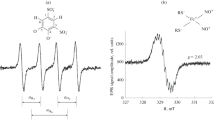Abstract
The effect of nickel on superoxide dismutase activity (SOD), as well as on rate of hydroxydopamine oxidation, was studied in vitro since lipid peroxidation has been implicated in cell damage by nickel, whose toxicity and carcinogenicity are well established.
Nickel strongly inhibits SOD activity. The degree of inhibition is directly proportion to the nickel concentration (tested range 0.066 to 0.33 μg/mL in the reaction mixture); to the substrate concentration (tested range 0.4×10−4 M to 1.1×10−4 M 6-hydroxydopamine); and to reaction mixture.
Autoxidation of 6-hydroxydopamine was increased by nickel concentrations higher than 15 μg/mL.
The combination of excessive oxygen free radical production and inhibition of their elimination by inhibition of SOD activity may contribute to the nickel toxicity that has been reported in industrial accidents, as well as to the high incidence of cancer occurring in nickel workers. It may also contribute to many complications in uremic patients, in whom increased serum nickel levels were reported to be in a similar range to those inhibiting SOD.
Similar content being viewed by others
References
E. W. Baader, Neue Ergebnisse auf dem gebiete der Krebskrankheitan, C. 0 Adam, D. S. Auler,Hirzel Verlag, Leipzig, (1937), pp. 116, 117.
J. A. Cambell,Brit. J. Indust. Med. 15, 217–223, (1958).
Hatem, S. Chanpy,C. R. Acad. Sci. 253, 2791, 2792 (1961).
H. Sky-Peck,Clin. Phys. Bio., Y. pp. 99–111 (1986).
F. W. Sunderman,Annals of Clin. Lab Sci. 19, 11–16 (1989).
F. W. Sunderman,Acta pharmacologica et toxicologica,7, 248–255 (1986).
S. M. Denke and B. L. Fenburg,N. Engl. J. of Med.,303, 77–86, (1980).
A. P. Autor, inThe Biology and Chemistry of Active Oxygen, J. W. Bannister, W. H. Bannister, eds, Elsevier, NY, 1984, pp. 139–145.
J. Fridovich,Ann. Rev. Biochem.,44, 147–159, (1975).
E. D. Getzoff, J. A. Tainer, P. K. Weiner, P. M. Kollman, J. S. Richardson, C. Richardson,Nature,36, 287–289 (1983).
R. E. Heikkila, F. Cabbot,Anal. Biochem.,75, 356–362 (1977).
R. Shainkin-Kestenbaum, A. J. Adler, G. M. Berlyne, and C. Caruso,Clin. Science,77, 463–466 (1989).
A. Petkua,Cancer Treatment Reviews,13, 17–44 (1986).
H. B. Demopoulos, E. S. Flamm, M. L. Seligman, D. D. Pietronigro, J. Tomasula, and V. Decrescito,Canadian J. of Phys. Pharm. 60, 1415–1424 (1982).
M. S. Paller, J. R. Holdal, and T. F. Ferris,J. of Clin. Invest. 74, 1156–1164 (1984).
J. E. Veltishcher,Cont. to Neph. 63, 28–30 (1988).
I. M. Schranfstatter, S. D. Revak, and G. G. Cochrane,J. Clin. Invest. 73, 1175–1184 (1984).
J. C. Fantone, inOxygen Radicals and Tissue Injury, Boray Halliwell, ed., (1988), pp. 63–80, Upjohn, Bethesda.
G. Bertrand and H. Nakamura,Bull. Soc. Sci. Hyg. Aliment. 24, 238–343 (1936).
R. E. Tedeschi and F. W. Sunderman,AMA Arch. Indust. Health,167, 484–488 (1957).
S. Indraprasit, G. V. Alexander, and G. Gonick,J. Chron. Disease,27, 135–161 (1974).
H. P. Misra, and I. Fridovich,J. Biol. Chem. 247, 3170–3175.
A. J. Matas, R. L. Simmons, C. M. Kjellstrand, T. J. Buselmeier, and J. Najarian,Lancet,1, 883–886 (1975).
Author information
Authors and Affiliations
Rights and permissions
About this article
Cite this article
Shainkin-Kestenbaum, R., Caruso, C. & Berlyne, G.M. Effect of nickel on oxygen free radical metabolism. Biol Trace Elem Res 28, 213–221 (1991). https://doi.org/10.1007/BF02990468
Received:
Accepted:
Issue Date:
DOI: https://doi.org/10.1007/BF02990468



